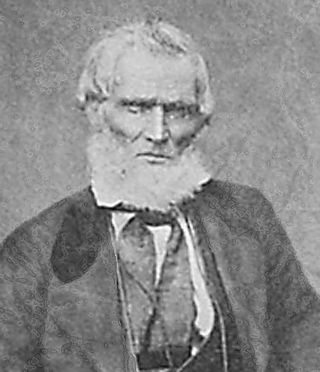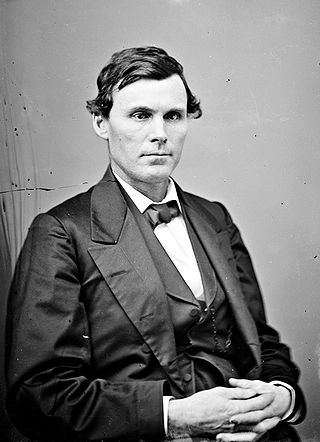Related Research Articles

Fillmore is a city and the county seat of Millard County, Utah, United States. The population was 2,592 at the 2020 United States Census. It is named for the thirteenth U.S. President Millard Fillmore, who was in office when Millard County was created by the Utah Territorial legislature.

Payson is a city in Utah County, Utah, United States. It is part of the Provo–Orem Metropolitan Statistical Area. The population was 21,101 at the 2020 census.
The Territory of Washington was an organized incorporated territory of the United States that existed from March 2, 1853, until November 11, 1889, when the territory was admitted to the Union as the State of Washington. It was created from the portion of the Oregon Territory north of the lower Columbia River and north of the 46th parallel east of the Columbia. At its largest extent, it also included the entirety of modern Idaho and parts of Montana and Wyoming, before attaining its final boundaries in 1863.

The Utah Territorial Statehouse, officially Territorial Statehouse State Park Museum, is a state park in Fillmore, Utah, preserving the original seat of government for the Utah Territory. Built from 1852 to 1855, the statehouse was initially intended as a larger structure, but only the south wing was completed before the project was abandoned due to lack of federal funding, and the Utah Territorial Legislature met in the building only once before the capital was moved to Salt Lake City in 1856.

The 1852–53 United States House of Representatives elections were held on various dates in various states between August 2, 1852 and November 8, 1853. Each state set its own date for its elections to the House of Representatives before the first session of the 33rd United States Congress convened on December 5, 1853. The size of the House increased to 234 seats following the congressional reapportionment based on the 1850 United States census.

Jefferson Hunt was a U.S. western pioneer, soldier, and politician. He was a captain in the Mormon Battalion, brigadier general in the California State Militia, a California State Assemblyman, and a representative to the Utah Territorial Legislature.

William Whitaker Taylor was a member of the Utah Territorial Legislature, member of the Presidency of the Seventy in the Church of Jesus Christ of Latter-day Saints, and a son of LDS Church president John Taylor. He was a half brother to John W. Taylor, a member of the Quorum of the Twelve Apostles who was dropped from the body and excommunicated for refusing to give up plural marriage, and a brother-in-law to George Q. Cannon.

Benjamin Franklin Harding was an American attorney and politician born in Pennsylvania. He held political offices in the Oregon Territory and later served as a United States senator from the state of Oregon.

George Law Curry was a predominant American political figure and newspaper publisher in the region that eventually became the state of Oregon. A native of Pennsylvania, he published a newspaper in St. Louis, Missouri, before traveling the Oregon Trail to the unorganized Oregon Country. A Democrat, Curry served in the new Oregon Territory's government as a representative to the legislature and as Territorial Secretary before appointment as the last Governor of the Oregon Territory. Curry County in Southern Oregon is named in his honor.

William Bowker Preston was the fourth Presiding Bishop of the Church of Jesus Christ of Latter-day Saints between 1884 and 1907.

Oregon's Territorial Legislature was a bicameral legislative body created by the United States Congress in 1848 as the legislative branch of the government of the Oregon Territory. The upper chamber Council and lower chamber House of Representatives first met in July 1849; they served as the region's legislative body until Oregon became a state in February 1859, when they were replaced by the bicameral Oregon State Legislature.
Joseph Conant Avery was the founder of Corvallis, Oregon. Avery was the first postmaster for the community, and served as a legislator in the Provisional Government of Oregon and the government of the Oregon Territory. Avery House at Oregon State University was named after him.

The 1852–53 United States Senate elections were held on various dates in various states, coinciding with the 1852 presidential election. As these U.S. Senate elections were prior to the ratification of the Seventeenth Amendment in 1913, senators were chosen by state legislatures. Senators were elected over a wide range of time throughout 1852 and 1853, and a seat may have been filled months late or remained vacant due to legislative deadlock. In these elections, terms were up for the senators in Class 2.
The Minnesota Territorial Legislature was a bicameral legislative body created by the United States Congress in 1849 as the legislative branch of the government of the Territory of Minnesota. The upper chamber, the Council, and the lower chamber, the House of Representatives, first convened on September 3, 1849. The two chambers served as the territory's legislative body until Minnesota was admitted as a state on May 11, 1858, when the Territorial Legislature was replaced by the Minnesota Legislature.
The fourth Minnesota Territorial Legislature first convened on January 5, 1853. The 9 members of the Minnesota Territorial Council were elected during the General Election of October 14, 1851, and the 18 members of the Minnesota House of Representatives were elected during the General Election of October 12, 1852.
William Myron King, also known as Colonel King for most of his life, was an American pioneer merchant and Oregon state legislator. He served four terms in Oregon's territorial legislature. This included one term as Speaker of the Oregon House of Representatives during the 1851 legislative session. Before immigrating to Oregon, King lived and worked in New York, Pennsylvania, Ohio, and Missouri. After moving to Oregon in 1848, he became a merchant in Portland, and was later the county judge for Multnomah County and a member of Portland's city council.
References
- ↑ The published acts and resolutions passed by the 2nd Utah Territorial Legislature lists the session as beginning on the second Monday of December; the year is correctly stated as 1852 on the title page, although elsewhere it is incorrectly given as commencing in December 1853 and adjourning in January 1853.